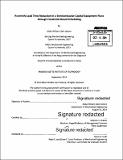| dc.contributor.advisor | Stephen C. Graves. | en_US |
| dc.contributor.author | Sedore, Blake William Clark | en_US |
| dc.contributor.other | Massachusetts Institute of Technology. Department of Mechanical Engineering. | en_US |
| dc.date.accessioned | 2015-02-05T18:29:26Z | |
| dc.date.available | 2015-02-05T18:29:26Z | |
| dc.date.copyright | 2014 | en_US |
| dc.date.issued | 2014 | en_US |
| dc.identifier.uri | http://hdl.handle.net/1721.1/93851 | |
| dc.description | Thesis: M. Eng. in Manufacturing, Massachusetts Institute of Technology, Department of Mechanical Engineering, 2014. | en_US |
| dc.description | Cataloged from PDF version of thesis. | en_US |
| dc.description | Includes bibliographical references (page 80). | en_US |
| dc.description.abstract | The assembly protocols for a semiconductor capital equipment machine were analyzed for potential lead time reduction. The objective of this study was to determine the minimum assembly lead time for the machine based on the constraints of design, space, and labor availability. An assembly requires the completion of a set of procedures that each contains assembly tasks. Precedence relationships between tasks indicate for each procedure what other tasks must be completed before it can start. Each procedure was assumed to have constant resource requirements throughout its duration. The Critical Path Method (CPM) was used to identify 13 procedures on the critical path, based on design and space constraints. A preliminary build schedule was developed that prioritized critical path procedures. A trial of this build schedule achieved an assembly lead time of 39 hours, resulting in a 70% reduction from the current average of 5.5 days. This trial was also accomplished with 76% of the average labor hours for assembly. A production build schedule with a lead time of 43 hours was developed based on the trial results. This schedule allows for production rates of up to 5 machines per week to be achieved with the current shift structure of the company, without the incurrence of overtime. A critical path drag analysis identified critical procedures with the highest potential for lead time reduction. The highest drag of a critical path item was 260 minutes, accounting for 10% of the assembly lead time. | en_US |
| dc.description.statementofresponsibility | by Blake William Clark Sedore. | en_US |
| dc.format.extent | 83 pages | en_US |
| dc.language.iso | eng | en_US |
| dc.publisher | Massachusetts Institute of Technology | en_US |
| dc.rights | M.I.T. theses are protected by copyright. They may be viewed from this source for any purpose, but reproduction or distribution in any format is prohibited without written permission. See provided URL for inquiries about permission. | en_US |
| dc.rights.uri | http://dspace.mit.edu/handle/1721.1/7582 | en_US |
| dc.subject | Mechanical Engineering. | en_US |
| dc.title | Assembly lead time reduction in a semiconductor capital equipment plant through constraint based scheduling | en_US |
| dc.type | Thesis | en_US |
| dc.description.degree | M. Eng. in Manufacturing | en_US |
| dc.contributor.department | Massachusetts Institute of Technology. Department of Mechanical Engineering | |
| dc.identifier.oclc | 900982970 | en_US |
